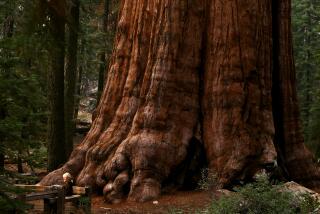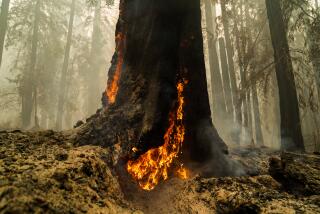Terry Tempest Williams thinks, breathes and writes deeply in our national parks
Terry Tempest Williams would like it very much if everyone could just take a deep breath.
“Our national parks are breathing spaces, in a time when we’re all holding our breath,” the author and environmentalist says. In her new book, “The Hour of Land: A Personal Topography of America’s National Parks,” Tempest Williams considers the meaning and role of the parks in 12 eloquent personal essays.
In the book, Tempest Williams speaks softly but carries a big walking stick as she wanders, and wonders about, some of America’s most visited and hallowed sites.
If we can learn to listen to the land, we can learn to listen to each other.
— Terry Tempest Williams
“I wasn’t writing about the national parks, I was writing about America,” she explained by phone from New Hampshire, where the Utah native is a visiting professor at Dartmouth College. “It became clear that our national parks may not just be our best idea, but an evolving idea.”
Neither travelogue nor tour guide, her descriptions of these places — which reference biology, history, archaeology, anthropology, folklore, zoology, ornithology, politics, geology and geography — resonate because she frames topics and issues among the storied settings that are part of our shared legacy.
The national parks are a microcosm for the challenges of a rapidly changing society, Tempest Williams explains. “Our parks have become a hologram for the problems we are facing,” she says, citing climate change, fracking, de-listing of endangered species, population growth, economics and social divisions.
At Gettysburg National Battlefield, she encounters Civil War re-enactors who reveal that their sympathies lie with the South. It’s a moment that exposes just how polarized these United States can be, long after the North vanquished the Confederacy.
At Big Bend National Park in Texas she ponders the disastrous effects a wall between Mexico and the United States would inflict upon the wildlife of the hard country along the Rio Grande, the largest preserve of Chihuahuan desert in the United States.
In the chapter about Gates of the Arctic National Park, she turns inward, contemplating the wilderness as metaphor as she meditates on a fracture in her relationship with her brother. “Wilderness is not my leisure or my recreation. It is my sanity,” she writes.
It’s a recurring theme: Wide open spaces promote wide open thoughts. Panorama promotes perspective. “If we can learn to listen to the land,” she says, “we can learn to listen to each other.”
“The Hour of Land” is handsomely illustrated with black-and-white photographs by Ansel Adams, Richard Avedon, Lee Friedlander, Sally Mann and many others. The photographs selected for the book are not literal representations of the places Tempest Williams writes about but a nod to the men and women who drew attention to the parks through their pictures. “National parks would never be what they are had the photographers not advocated for them,” she says.
Tempest Williams has been connected to the land all her life. She was raised in Utah, where her family’s traditions include a deep and abiding appreciation of the natural world. In her essay about Grand Teton National Park, which she revisits with her father, Tempest Williams describes generations of Tempests before her gathering there, returning summer after summer to replenish their souls.
See the most-read in Life & Style this hour »
But the parks and monuments are much more than vacation destinations meant to be driven to on interstate highways and through on roads paved by the National Park Service that Edward Abbey decried in “Desert Solitaire: A Season in the Wilderness.” Referencing Abbey, she says, “I love that Ed called it ‘industrial tourism.’”
“Last year you were just inches — back to back — with other people in the Yellowstone basin,” she says. But a visit to a national park in Texas with her husband proved quite different. “The other side is, you look at a park like Big Bend and there were days Brooke and I saw two people.”
Now, Tempest Williams says, we have arrived at a tipping point where people and governmental agencies must redouble efforts to preserve and protect the wild. She put her money where her mouth is earlier this year by purchasing energy leases for more than 1,000 acres of wilderness near her home in Castle Valley, Utah. The parcels, she says, are “scraps” that attracted no bidders during a Bureau of Land Management auction. So she purchased them post-auction.
Tempest Williams and her husband paid $1.50 per acre to lease the property for 10 years. In news reports about the transaction, after being asked by a BLM official whether the couple’s motivation in buying the leases was in fact for energy exploration, Tempest Williams famously answered, “Yes. You can’t define what energy is for us. Our energy development is fueling a movement. Keep it in the ground.”
Not long after she had taken out the leases, the ground shifted under Tempest Williams’ feet during contract negotiations with the University of Utah, where she had founded and taught in the Environmental Humanities graduate program. In April, she resigned from the university rather than take her teaching about the environment, which had been conducted in the field, into the classroom.
When asked whether her BLM auction action had anything to do with the university’s stance during the contract discussions, Tempest Williams demurs. In an email she writes, “It can be described best in one word: Politics.”
Not one to stand still for too long, Tempest Williams has been on the move lately between Castle Valley, New Hampshire and Colorado, where she was a speaker at the 8th World Ranger Congress in Rocky Mountains National Park. Nearly 400 rangers from parks and preserves all over the world attended the conference, sharing tales of triumphs and challenges they face in protecting the wild.
“The women moved me deeply,” Tempest Williams says, describing the extreme dangers and difficulties park personnel face in other parts of the world, including rebel factions and lions. “A woman ranger from Cameroon who had made a vow to protect wildlife with her life was nearly beaten to death by poachers.”
The National Park Service officially marks its centennial on Aug. 25; Tempest Williams will be visiting one. She encourages everyone else to find “their” national park – what she calls “the open spaces of our democracy” -- to take part in the celebration. There are a total of 58 national parks across 29 states, with an additional 120 national monuments across the nation.
“Writing this book has allowed me to fall in love with our country again — what’s the best in us,” she says quietly.
-----------
FOR THE RECORD
June 10, 2:00 p.m.: An earlier version of this article incorrectly stated that there are national parks in every U.S. state.
-----------
::
“The Hour of Land: A Personal Topography of America’s National Parks”
Terry Tempest Williams
Farrar, Straus and Giroux: 396 pp., $27
More to Read
Sign up for our Book Club newsletter
Get the latest news, events and more from the Los Angeles Times Book Club, and help us get L.A. reading and talking.
You may occasionally receive promotional content from the Los Angeles Times.






